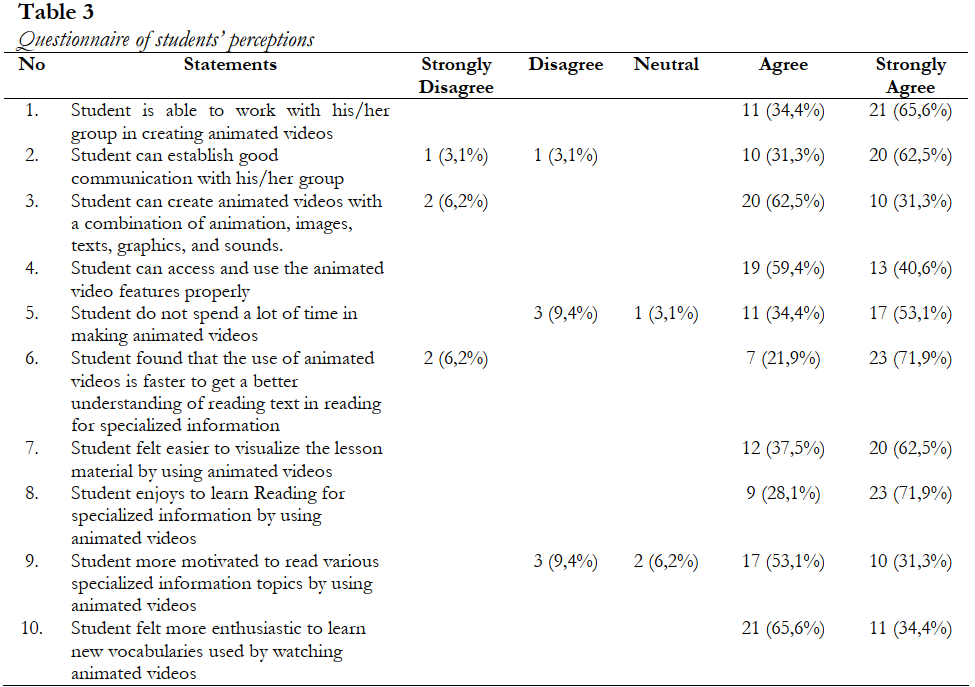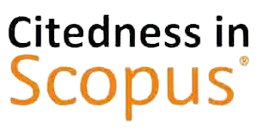The implementation of project-based learning through animated videos in reading for specialized information
DOI:
https://doi.org/10.33474/j-reall.v5i1.21500Keywords:
animated videos, project-based learning, reading for specialized informationAbstract
This research investigated the implementation of project-based learning through animated videos in reading for specialized information and the perception of students on it. This research differed from others because students visualized the information from the reading text into animated videos. The implementation of project-based learning through animated video was measured by observation. Students’ perceptions about it were measured from the questionnaire. Thirty-two vocational students took part in this research. Based on the results of observations, three steps of project-based learning supported students’ success in achieving the learning outcomes. The result showed that students’ positive responses about the process of creating animated videos were: they worked with group (65,6%); they tried to design their animated videos (62,5%); they accessed and used features properly (59,4%); and they enjoyed to learn reading for specialized information (71,9%). Students’ positive responses about the benefits of creating animation videos were: they established good communication (62,5%); they got a better understanding (71,9%); they felt easier to visualize the lesson material (62,5%); they were more motivated to read (53,1%), and they felt more enthusiastic to learn new vocabularies (65,6%). On the other hand, students’ negative responses showed that they spent a lot of time in making animated videos (9,4%). Lecturers recommended using easy and basic applications in creating animated videos, such as Canva. The implication of the research was students developed their creativity to visualize a reading text in the form of animated videos, and they understood the reading text.
References
Alghonaim, A. S. (2020). Impact of related activities on reading comprehension of EFL students. English Language Teaching, 13(4), 15–27. https://doi.org/10.5539/elt.v13n4p15
Almulla, M. A. (2020). The effectiveness of the project-based learning (PBL) approach as a way to engage students in learning. SAGE Open, 10(3), 1–15. https://doi.org/10.1177/2158244020938702
Apriani, E., Arsyad, S., Syafryadin, Supardan, D., Gusmuliana, P., & Santiana. (2022). ICT platforms for Indonesian EFL students viewed from gender during the Covid-19 pandemic. Studies in English Language and Education, 9(1), 187–202. https://doi.org/10.24815/siele.v9i1.21089
Ardiansyah, W., Meirani, W., & Risnawati. (2022). Boosting students’ reading comprehension attainment with flipped classroom model: A pilot study at State Polytechnic of Sriwijaya. International Online Journal of Education and Teaching (IJOET), 9(2), 871–883.
Arifani, Y., Asari, S., Anwar, K., & Budianto, L. (2020). Individual or collaborative WhatsApp learning? A flipped classroom model of EFL writing instruction. Teaching English with Technology, 20(1), 122–139.
Arifin, S., Arifani, Y., Maruf, N., & Helingo, A. (2022). A case study of EFL teacher scaffolding of an ASD learner’s shared reading with a storybook app. The Journal of Asia TEFL, 19(4), 1234–1249.
Espinoza-Celi, V., & Pintado, C. M. (2020). Using twitter to enhance writing skill with senior high school students: A case study. Teaching English with Technology, 20(5), 108–124.
Fatimah, S., Tiarina, Y., Fitrawati, & Mira, A. S. (2021). English teachers’ and lecturers’ perceptions of reflective practice through video recording at the teacher certification program. Studies in English Language and Education, 8(2), 670–689. https://doi.org/10.24815/siele.v8i2.18931
Guo, P., Saab, N., Post, L. S., & Admiraal, W. (2020). A review of project-based learning in higher education: Student outcomes and measures. International Journal of Educational Research, 102, 1–13.
Habibi, A., Riady, Y., Alqahtani, T. M., Rifki, A., Albelbisi, N. A., Fauzan, M., & Habizar, H. (2022). Online project-based learning for ESP: Determinants of learning outcomes during covid-19. Studies in English Language and Education, 9(3), 985–1001. https://doi.org/10.24815/siele.v9i3.24928
Husnawadi. (2021). Students’ perceptions of flipped classroom-mediated task: Insights from an Indonesian post-earthquake EFL writing pedagogy. Teaching English with Technology, 21(1), 8–28.
Kasim, A. A. M., Darus, N. A., Lee, N. A. A., Subramaniam, A. L. B., & Januin, J. (2022). Online collaborative performance in group-based tasks among learners of higher education. Studies in English Language and Education, 9(3), 948–966. https://doi.org/10.24815/siele.v9i3.24861
Kusuma, I. P. I. (2022). EFL teachers’ online teaching in rural schools during the Covid-19 pandemic: stories from Indonesia. Studies in English Language and Education, 9(1), 203–221. https://doi.org/10.24815/siele.v9i1.21239
Lestari, N. P. Y., & Wibawa, I. M. C. (2021). Learning videos to improving students’ reading comprehension in elementary school. International Journal of Elementary Education, 5(2), 276–283. https://doi.org/10.23887/ijee.v5i2.34405
Loi, N. Van, & Hang, C. T. T. (2021). Integrating project work into english proficiency courses for pre-service teachers’ training. TESL-EJ: The Electronic Journal for English as a Second Language, 25(3), 1–20.
Mulyani, M., Fidyati, F., Suryani, S., Suri, M., & Halimatussakdiah, H. (2021). University students’ perceptions through e-learning implementation during Covid-19 pandemic: Positive or negative features dominate? Studies in English Language and Education, 8(1), 197–211. https://doi.org/10.24815/siele.v8i1.17628
Muslem, A., Sahardin, R., Heriansyah, H., Fata, I. A., Djalaluddin, Y., & Hankinson, E. (2022). YouTube teaching materials with peer support to improve students’ mastery of subject content learning. Studies in English Language and Education, 9(2), 651–666. https://doi.org/10.24815/siele.v9i2.25236
Ramli, K., Assaiqeli, A., Mostafa, N. A., & Singh, C. K. S. (2022). Gender perceptions of benefits and challenges of online learning in Malaysian ESL classrooms during Covid-19. Studies in English Language and Education, 9(2), 613–631. https://doi.org/10.24815/siele.v9i2.21067
Robillos, R. J. (2021). Learners’ writing skill and self-regulation of learning awareness using computer-assisted argument mapping (CAAM). Teaching English with Technology, 21(4), 76–93.
Rosyada, A., & Sundari, H. (2021). Learning from home environment: Academic writing course for EFL undergraduates through Google Classroom application. Studies in English Language and Education, 8(2), 710–725. https://doi.org/10.24815/siele.v8i2.18374
Santyasa, I. W., Rapi, N. K., & Sara, I. W. W. (2020). Project based learning and academic procrastination of students in learning physics. International Journal of Instruction, 13(1), 489–508.
Sari, A. S. (2021). Animated video in teaching reading comprehension viewed from the students’ reading interest. ELE Reviews: English Language Education Reviews, 1(2), 88–98. https://doi.org/10.22515/ele-reviews.v1i2.4062
Sari, T. Y., Ariyanto, S., & Wahjuningsih, E. (2021). Using animated video caption to improve the tenth grade students’ reading comprehension achievement. EFL Education Journal, 8(3), 163–171. https://doi.org/10.19184/eej.v8i3.25650
Schoch, K. (2020.) Case study research. USA: Sage Publication.
Shafira, R., & Rosita, N. (2022). Students’ perception on the use of audio-visual materials in learning English at senior high school. Journal of English Language Teaching, 11(3), 216–229. https://doi.org/10.24036/jelt.v11i3.118446
Sharif, S. R., Singh, C. K. S., Ong, E. T., Mulyadi, D., Ichsan, I. Z., Rahmayanti, H., & Kiong, T. T. (2023). The use of i-THINK mapping in teaching reading comprehension among ESL teachers. Studies in English Language and Education, 10(1), 78–95.
Spring, R. (2020). Can video-creation project work affect students’ oral proficiency? An analysis of fluency, complexity and accuracy. TESL-EJ: The Electronic Journal for English as a Second Language, 24(2), 1–17.
Syamdianita, & Cahyono, B. Y. (2021). The EFL pre-service teachers’ experiences and challenges in designing teaching materials using TPACK framework. Studies in English Language and Education, 8(2), 561–577. https://doi.org/10.24815/siele.v8i2.19202
Wang, S., & Lee, C.-I. (2020). Exploring the effectiveness of hypermedia glosses for second language reading. The Journal of Asia TEFL, 17(4), 1284–1293. https://doi.org/10.18823/asiatefl.2020.17.4.8.1284

Downloads
Published
How to Cite
Issue
Section
License
Copyright (c) 2024 Ririn Pratiwi Suharto, Zubaidi Zubaidi, Fitrotul Maulidiyah, Ardian Wahyu Setiawan, Dhony Manggala Putra

This work is licensed under a Creative Commons Attribution 4.0 International License.
Authors who publish this journal agree to the following terms:
- Authors retain copyright and grant the journal right of first publication with the work simultaneously licensed under a Creative Commons Attribution License that allows others to share the work with an acknowledgement of the work's authorship and initial publication in this journal.
- Authors can separately make additional contractual arrangements for non-exclusive distribution published by the journal (e.g., publish it in a book), with an acknowledgement of its initial publication in this journal.
- Authors are allowed and encouraged to send their work via online (e.g., in the institutional repositories or their website) after published by the journal.





















